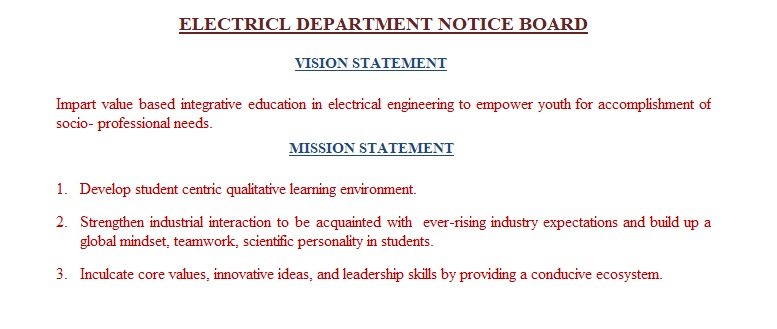Electrical Engineering Department
Syllabus
for Mid Semester of DC Machine and Transformer
SUBJECT CODE: 2130904
Module 2: D.C.
Machines:
Working
principle, construction and methods of excitation- Armature Winding:
Introduction of simplex lap and wave windings. DC generators: EMF equation methods
of excitation – separately and self-excited – shunt, series, compound armature
reaction – effects of armature reaction - demagnetizing & cross magnetizing
ampere-turns – compensating windings – inter poles – commutation – methods to improve commutation - voltage
build-up – no load characteristics- load characteristics – losses and
efficiency – power flow diagram –parallel operation – applications of DC
generators.
Module 3: Transformers:
Principle,
construction and operation of single phase transformers, phasor diagram,
equivalent circuit, voltage regulation, losses and efficiency, Testing-
Open & short circuit tests, Polarity test, Sumpner’s test, Separation of
hysteresis and eddy current losses, Autotransformers-Construction,
Principle, Applications and Comparison with two winding transformer
EXAMPLES RELATED TO ABOVE
TOPICS
Electrical Engineering
Department
Question Bank: DC Machine and
Transformer (3rd sem Electrical)
SUBJECT CODE: 2130904
|
C H A P T E R - 2
|
Sr No.
|
D.C. Machines:
|
|
1
|
Justify: Pole shoe section of DC machine is made larger than its body.
|
|
|
2
|
Draw and explain characteristics of DC series generator. Also enlist
applications of DC series generator.
|
|
|
3
|
Define armature reaction. Explain armature reaction effect in DC
machine. How it can be minimized?
|
|
|
4
|
Explain each part of DC machine with neat sketch.
|
|
|
5
|
What is armature reaction? Explain the methods to overcome the adverse
effect of the armature reaction.
|
|
|
6
|
Explain the load characteristics of DC shunt generator.
|
|
|
7
|
What is commutation?
|
|
|
8
|
Explain the O.C characteristic of DC shunt Generator, also define the
critical resistance & speed from the characteristic.
|
|
|
9
|
Write D.C. machine nameplate with
significance of each name.
|
|
|
10
|
Write Function and location of inter
poles and commutating winding in D.C generator.
|
|
|
11
|
Give the classification of DC
generator.
|
|
|
12
|
Mention the parts of a DC machine.
Explain the use of any one of them.
|
|
|
13
|
What is the function of brushes in DC machine?
|
|
|
14
|
Describe various losses in a DC
machine and derive the equation of efficiency of DC machine as a motor and as
a generator.
|
|
|
15
|
Derive the emf equation of a DC
generator.
|
|
|
16
|
Compare lap and wave winding.
|
|
|
17
|
What is the necessity of starter in
a DC motor? Name the starters for DC motors.
|
|
|
18
|
Discuss retardation test on D.C machine.
|
|
|
19
|
Derive the torque equation of a DC
motor from first principles.
|
|
|
20
|
Explain critical field resistance of
d.c. shunt generator with its significance.
|
|
|
21
|
Discuss conditions to be satisfied
for a self-excited generator to build up voltages.
|
|
|
22
|
Derive the expression of armature
torque developed in a dc motor using fundamental equation and power equation.
Draw the speed-torque characteristics of shunt, series and compound motors.
|
|
|
23
|
Numerical on above mention topics
|
|
|
C H A P T E R - 3
|
|
Transformers:
|
|
1
|
Justify: C.T secondary should never
be kept open in any circumstances.
|
|
|
2
|
Discuss essential and desirable
conditions to be satisfied for parallel operation of two single phase
transformers.
|
|
|
3
|
Explain
direct load test on single phase transformer with circuit diagram.
|
|
|
4
|
Derive an expression for saving of
copper when auto transformer is used compared to Two winding transformer.
|
|
|
5
|
Explain
direct load test on single phase transformer with circuit diagram.
|
|
|
6
|
Explain
direct load test on single phase transformer with circuit diagram.
|
|
|
7
|
Explain O.C & S.C. test on 1-Φ
transformer.
|
|
|
8
|
Explain the constructional details
of transformer.
|
|
|
9
|
Explain the transformer ON-LOAD with
vector diagrams
|
|
|
10
|
Can DC supply be applied to a
transformer?
|
|
|
11
|
Draw phasor diagram for no load
condition in transformer.
|
|
|
12
|
Why transformer rating in KVA?
|
|
|
13
|
What is transformation ratio?
|
|
|
14
|
Explain Sumpner’s
test for testing of a transformer.
|
|
|
15
|
Explain
the concept of ideal transformer.
|
|
|
16
|
Derive the
expression for voltage regulation of a transformer on lagging & leading
power factor loads.
|
|
|
17
|
Briefly
describe the principle of operation of a transformer.
|
|
|
18
|
Give a
comparison of an auto transformer with a two winding transformer.
|
|
|
19
|
Define
“All day efficiency” and % regulation of transformer.
|
|
|
20
|
Derive the
equivalent circuit of a single phase transformer and show how it is useful in
the analysis of the performance of a transformer.
|
|
|
21
|
Derive
expression which shows comparison of copper required in auto transformer and
two-winding transformer.
|
|
|
22
|
Numerical on above mention topics
|

No comments:
Post a Comment